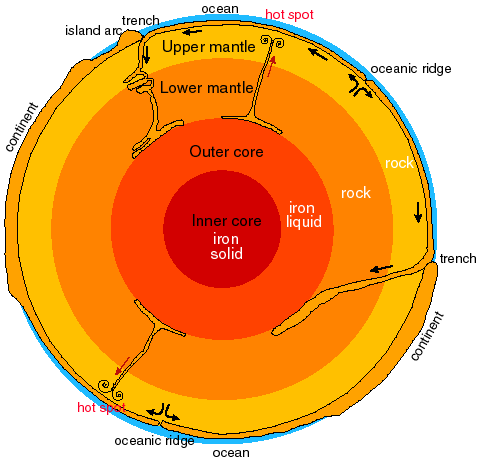With the exploratory glamor being hogged by the space program, it is good to remind ourselves of the vast unexplored regions of the Earth.
Here is a nice graphic that shows what happens as we go down deep into the ocean. Of course, we don’t really know for sure since going deep is a formidable challenge. The deep ocean is largely an unexplored frontier.
I had not been aware until I saw this that two explorers Don Walsh and Jacques Piccard had in January 1960 actually gone down to the deepest point in the ocean, a place known as Challenger Deep which is at a depth of almost 11,000 meters in the Mariana Trench in the Pacific Ocean. They did it in the bathyscaphe Trieste. The round trip took about eight and a half hours, with only about 20 minutes spent at the bottom.
Surprisingly, no manned craft ever returned to that depth (though robotic vehicles have) so Walsh (now 80 years old) is the only living human ever to have reached the bottom of the ocean. The pressure down there is over a 1000 times atmospheric pressure and it was thought that fish could not survive at such pressures but Walsh and Piccard reported seeing small fish swimming around.
As the graphic below shows, the deepest part of the ocean is just a tiny fraction of the distance to the center of the Earth. (If you want to see the depth of each layer, see here. Note that the figure is not quite to scale.)
It is humbling to think that despite humans being around for millions of years, we have exhaustively explored just a tiny fraction of our own planet.


I had a discussion with a friend about the possibility of life on other planets and SETI receiving some type of communication from such a planet. My friend said something I hadn’t thought of.
He said that if life on another planet existed it is possible that their world is perpetually covered in clouds. If true, then its possible the people on that world don’t really look ‘up’ as much as they look ‘down.’
Without the ability to see the stars or a moon people might not develop a culture of ‘what’s out there.’ In the absence of that, they might develop a stronger urge to explore what’s under the ground.
Just something I found interesting.
Well, get cracking on that Unobtanium so we can drill down to the core of the Earth
You really didn’t know about the Trieste? I suppose that is the sort of thing that can happen when one actually, you know, focuses himself on one or a few particular disciplines. In a manner of which I am apparently incapable. :p
Recently, it was discovered that the Challenger Deep has an even deeper bit.
I’ve seen several good programs since the ’70s (inclusive) on this, and read one or two books which treated this dive in their chapters. There is actually a recent program entirely about this dive, but I can’t recall which channel* airs** it (Science, H2, NatGeo). But I’ll look it up right now.
Something else along the lines of the lithospheric bit of your post is Drain the Ocean. I’m not really a huge fan of television, but DVR makes it bearable to the point where I can actually watch anything. And disappointing science programming is erased with the press of a button.
Here’s a short overview:
http://www.history.com/videos/submerisble-trieste-makes-worlds-deepest-sea-dive
Gah. These sites make it a complete pain to find out what programs they’ve aired by searching keywords. And I’d swear that generic internet search is just getting worse as well.
I think this was it:
http://newswatch.nationalgeographic.com/2010/04/15/don_walsh_and_the_deepest_dive/
although it is presented as a news blog item.
Heaven forbid channel websites actually list or make easily searchable their main product. (It isn’t just them, of course. Just yesterday, for example, Logitech denied the existence of my mouse until I changed my country to Singapore. Go figure.)
Isn’t that where the game of cricket comes from?
No, I really didn’t know about it. I was a young boy in Sri Lanka at that time where we did not have TV. (TV was introduced to the country only in 1977 so we went straight to color and missed the B&W era.)
It would have been covered in the newspapers but I could easily have missed it.
You might want to look at this website
http://www.worlddreambank.org/P/PLANETS.HTM
particulary Siphonia & Abyssia for interesting perspectives on the deep ocean.
@James: I think that’s true only 42% of the time, and also it may have something, coincidently, to do with sentient mattresses.
Good for Don Walsh and Jacques Piccard! It’s not like everyone has a chance to explore the ocean, must have been hard though.
I certainly would have missed it in the papers, from my disdain of the local papers if not for timing.
I was lucky enough to be exposed to the magic of PBS (WVIZ, as WNEO/WEAO came in pretty fuzzy back then), even though I didn’t watch much TV. This, and the occasional mention in books is why I had any idea about the dive; generally the simple fact that it happened. I expect it is even a minor bit of popular trivia -- deepest place in the ocean and all. But at some point early on I read about all the research bathyspheres and bathyscapes, although oceanography wasn’t one of my main interests.
Anyway. Now that I found the title, I just bypassed NatGeo and found not just a reference, but the entire program (in 2 parts):
Deepest Dive:
The Story Of The Trieste
And here’s the most recent vehicle to explore the Challenger Deep, the Nereus:
HROV Nereus Expedition to the Mariana Trench
Hybrid Remotely Operated Vehicle Nereus
There is a 2009 program from Discovery/Science Channel Dive to the Bottom of the World. It has been “airing” again recently. Uh… heck, it was on at 04:00 EST this morning. Oh, well.